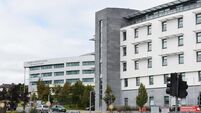Building owner goes on the run as death toll reaches 260
Many more of the mostly female workers were still feared trapped in the rubble more than 24 hours after the disaster, which has brought renewed attention to Western firms who use Bangladesh as a source of low-cost goods.
In the evening, local residents were still pulling survivors and bodies from the wreckage of the Rana Plaza building in the commercial suburb of Savar, 30km outside the capital Dhaka, using crowbars and their bare hands in sweltering heat. More than 1,000 people were injured.
“I thought there was an earthquake,” said Shirin Akhter, 22, who was starting her day at the New Wave Style workshop six floors up when the complex crumbled.
Akhter was trapped for hours before breaking through a wall. She says her monthly wage was $38.
Relatives identified their dead among rows of corpses wrapped in white cloth in a nearby school field.
Police said the owner of the building, local politician Mohammed Sohel Rana, was told of dangerous cracks on Tuesday.
While a bank in the building closed on Wednesday, the factories told their workers there was no danger, industry officials said. Rana is now on the run, according to police.
“An unspecified number of victims are still trapped,” said Mizanur Rahman, a rescue worker with the fire brigade, as he clambered over the wreckage. “We can’t be certain of getting them all out alive. We are losing a bit of hope.”
Dhaka’s district police chief Habibur Rahman said the death toll could rise further.
The government declared a national day of mourning and flags were flown at half mast at all official buildings.
Dhaka city development authority had filed a case against the building’s owner for faulty construction, police chief Rahman said. It filed another case against the owner and the five garments factories for causing unlawful death.
Bangladesh Garment Manufacturers and Exporters’ Association (BGMEA) president Mohammad Atiqul Islam said there were 3,122 workers in the factories on Wednesday. He said that local officials had indicated the cracks the day before.
“We asked the garment owners to keep it closed,” Islam said.
Rana had told proprietors of the building’s five garment factories that the cracks were not dangerous, Islam added. “After getting the green signal from the plaza owner all the garment factories opened,” he said.
More than 1,000 textile workers besieged the BGMEA offices, pelting it with stones and clashing with riot police, TV channels showed. The workers demanded all garment factories be shut and the owners harshly punished for accidents.
Hundreds of students donated blood at a clinic in Savar after doctors at Dhaka hospitals said they couldn’t cope with the number of victims.
Firefighters and troops carried young women survivors of the accident on stretchers, some apparently semi-conscious.
Irish clothing chain Penneys has confirmed that one of its suppliers occupied part of the Rana Plaza building that collapsed. A statement on the company’s website said: “The company is shocked and deeply saddened by this appalling incident at Savar, near Dhaka, and expresses its condolences to all of those involved.”
The Rana Plaza building collapse follows a fire at the Tazreen Fashion factory on the outskirts of Dhaka that killed 112 people in November and another incident at a factory in January in which seven people died, compounding concerns about worker safety and low wages in Bangladesh.
Entry level wages in these factories start at 14 cents an hour, said Charles Kernaghan, with the Institute for Global Labour and Human Rights.
About 3.6m people work in Bangladesh’s garment industry, making it the world’s second-largest apparel exporter. The bulk of exports (60%) goes to Europe. The United States takes 23% and 5% goes to Canada.













